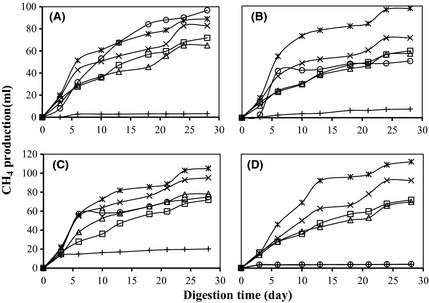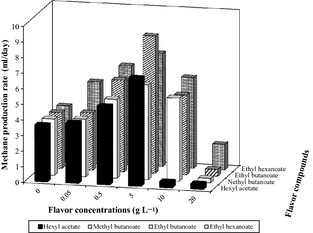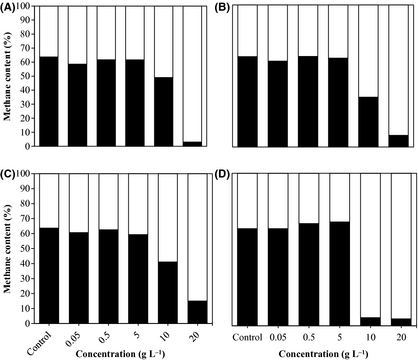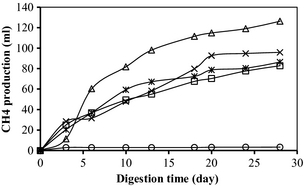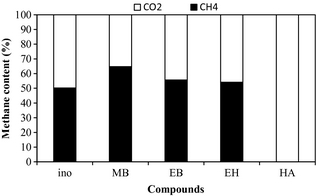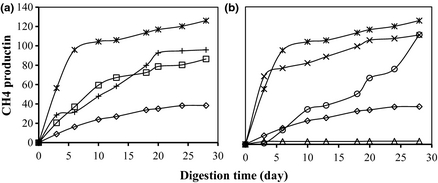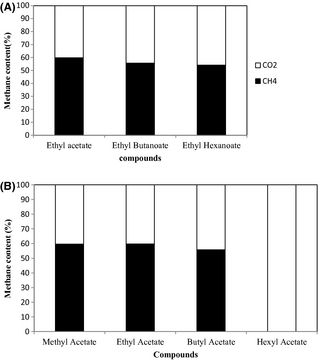Abstract
Esters are major flavor compounds in fruits, which are produced in high volume. The widespread availability of these compounds in nature attracts interest on their behavior in anaerobic digestion in waste and wastewater treatments. The aim of this work was to study the effects of various esters at different concentrations in anaerobic digestion followed by determination of their minimum inhibitory concentration (MIC), and to study the effect of chain length of functional group and alkyl chain of ester on methane production. Addition of methyl butanoate, ethyl butanoate, ethyl hexanoate, and hexyl acetate at concentration up to 5 g L−1 increased methane production, while their higher concentrations inhibited the digestion process. The MIC values for these esters were between 5 and 20 g L−1. Except hexyl acetate, the esters at concentration 5 g L−1 could act as sole carbon source during digestion. For ethyl esters, increasing number of carbon in functional group decreased methane production. For acetate esters, alkyl chain longer than butyl inhibited methane production. Effect of ester on methane production is concentration-dependent.
Introduction
Exploring and exploiting renewable and green energy is necessary in todays energy life style, not only because of the inevitable depletion of conventional sources of fossil energy but also due to the ecological-environmental effects caused by the conventional energy consumption. Biogas is a clean and renewable form of energy, which has a wide range of applications, such as vehicle fuel, cooking, heating, lighting, and electricity production. Biogas is produced by anaerobic degradation of organic substrates. Anaerobic digestion is one of the oldest processes and the most efficient treatment technologies, widely used for treating industrial wastes, municipal waste, and stabilization of wastewater sludge [1]. However, the fermenting organisms in biogas processes are sensitive to the process conditions and the substrate used. A wide variety of chemical substances have been reported to be inhibitory to the anaerobic digestion processes, resulting in decreasing or stopping the biogas production [2].
One of the chemical substances that could impact biogas production is ester. Ester is one of the most important classes of chemicals produced in high volume [3]. It is widely used in various industries such as solvents, plasticizer for cellulose, nail polish removers, perfumery product, plastic tubing, floor tiles, furniture, automobile upholstery, insect repellents, and as paint additive [3, 4]. Ester can be manufactured via chemical reaction by condensation of alcohols and carboxylic acids. In addition, it can be found in nature as the major volatile compounds in fruits. For instance, esters constitute 78–92%, 25–90%, and 13% of the total volatile mass of apple, strawberry, and raspberry, respectively [5]. Therefore, it is used as a flavor and fragrance compound in food industry. The widespread production and ability of some esters to migrate, make esters to be easily found in the environment [6].
Since anaerobic digestion is mostly used to tread wastewaters, investigation of effect of ester on anaerobic digestion is important. Esters might be beneficial or detrimental to the anaerobic digestion. Some esters are reported to be degraded by Acetobacterium woodii and Eubacterium limosum, which are involved in anaerobic digestion process [7]. However, some phthalate esters (PAE) could reduce the biogas production at a concentration higher than 60 mg L−1 [8]. Besides, some esters are reported having antimicrobial activity against some standard microorganisms. Butyl acetate and hexyl acetate at 4 μL and 8 μL, respectively, were toxic to Conidia germination after incubation for 24 h at 22°C [9]. Hexyl acetate at concentration 150 mg L−1 has significant inhibitory effect against E. coli, S. enteritidis, and L. monocytogenes that were isolated both in model system and in fresh-sliced apples [10]. To our knowledge, scarce information is available on the effect of esters in methane production.
In this study, some esters that are available in nature as fruit flavor compounds and mainly used in food, cosmetic, and solvent industries were examined. The aim of this study was to investigate the effects of the ester compounds on biogas production, and their minimum inhibitory concentration (MIC). In addition, the effect of chain length of functional group and alkyl chain of ester on biogas production was investigated.
Material and Methods
Microorganisms and chemicals
Inoculum (sludge) with 22 g VS L−1 (volatile solid per liter) was obtained from a thermophilic biogas plant (55°C) at Borås Energy and Environment AB (Borås, Sweden). The inoculum was then stored in an incubator at temperature 55°C for 3 days. A synthetic medium solution was prepared from 20 g L−1 of nutrient broth (Sigma-Aldrich, St. Louis, MO), 20 g L−1 of yeast extract (Merck KgaA, Darmstadt, Germany), and 20 g L−1 of glucose (Merck). Nutrient broth contained 10 g L−1 beef extract, 10 g L−1 peptone, and 5 g L−1 sodium chloride. The ester compounds (Sigma-Aldrich) used in this work were methyl butanoate, ethyl butanoate, ethyl hexanoate, hexyl acetate, methyl acetate, ethyl acetate, and butyl acetate.
The experiments were carried out in two steps. The first step was to investigate the effect of ester compounds on biogas production. In this step, the concentrations of methyl butanoate, ethyl butanoate, ethyl hexanoate, and hexyl acetate were 0.05, 0.5, 5, 10, and 20 g L−1 for each compound. The second step was to investigate the effect of chain length of functional group and alkyl chain of ester on biogas production. In this step, the concentration of ethyl hexanoate, ethyl butanoate, methyl acetate, ethyl acetate, butyl acetate, and hexyl acetate was 5 g L−1.
Anaerobic digestion
The method used for anaerobic digestion was adapted from the method described by Hansen et al. [11] and the OECD [12] with minor modifications. The experiments were carried out in a 120-mL glass bottle containing 50 mL of sludge, 1 mL of medium, and 2.5 mL of ester solution or distilled water (for a control). In order to measure methane production from the inoculum, the inoculum was incubated without addition of medium and ester solution in the glass bottle containing 50 mL of sludge and 3.5 mL of distilled water. The bottles were closed tightly and the headspace was filled with gas mixture containing 80% N2 and 20% CO2 to achieve anaerobic condition. The bottles were then incubated at 55°C for 28 days. During incubation, the bottles were shaken twice a day using water bath shaker (55°C) at 150 rpm. Gas samples were taken from headspace of the reactors through the septum using a syringe with pressure lock (VICI; Precision Sampling Inc., Baton Rouge, LA). Samples were taken at 3, 6, 9, 12, 15, 20, 25, and 30 days. The initial methane production rate was measured as the mean of methane production per day during the first 10 days.
Analytical methods
Biogas production from the digestion experiments was measured using Gas Chromatography (Varian 450 GC, Palo Alto, CA) with a capillary column (J 6 W scientific GS-Gas Pro, bonded silica based 30 m × 0.32 mm, Agilent Technologies, Santa Clara, CA) and a thermal conductivity detector (Varian, Palo Alto, CA). The conditions for the analysis were injector temperature of 75°C, oven temperature of 100°C, detector temperature of 120°C, and column flow (N2) 2 mL min−1.
All experiments were carried out in triplicate batch experiment; the result was presented in average ± standard deviation. At the end of digestion, the pH of the sludge was analyzed. For statistical analysis, analysis of variance (ANOVA) with significance level of 0.05 was performed using a statistical package for the social sciences (SPSS version 21, International Business Machine Corporation, Armonk, NY).
Results and Discussion
The widespread application and high-volume production of esters have caused high possibility of ester found in wastewater of many industries. Various esters at different concentrations and different chain lengths of functional group and alkyl chain were added into a batch anaerobic digestion system. The gas production was measured to indicate the inhibitory or enhancement effect of the esters to the system.
Are esters beneficial or detrimental for biogas production?
In order to investigate the effect of the ester on biogas production, methyl butanoate, ethyl butanoate, ethyl hexanoate, and hexyl acetate were added at different concentrations. The inoculum was incubated in the presence of these esters at five different concentrations that are 0.05, 0.5, 5, 10, and 20 g L−1. Table 1 and Figure 1 present a summary of the effects of esters on methane production.
| Ester | Concentration (g L−1) | Cumulative methane (mL) | Methane yield (L g−1 VS) | Enhancementa(%) | pH |
|---|---|---|---|---|---|
| |||||
| Inoculum | – | 46.7 ± 11.5 | 0.3 ± 0.19 | 0 | 7.74 |
| Control (medium + inoculum) | – | 71.8 ± 11.3 | 1.2 ± 0.19 | 0 | 7.74 |
| Methyl butanoate | 0.05 | 65.1 ± 2.4 | 1.08 ± 0.04 | −9.4b | 7.94 |
| 0.5 | 82.3 ± 3.7 | 1.33 ± 0.06 | 15.4 | 7.86 | |
| 5 | 89 ± 10 | 1.48 ± 0.17 | 24 | 7.89 | |
| 10 | 96.8 ± 0.9 | 1.61 = 0.02 | 34.8 | 7.84 | |
| 20 | 3.3 ± 0.6 | 0.05 ± 0.01 | −95.5 | 5.42 | |
| Ethyl butanoate | 0.05 | 68.9 ± 9 | 1.15 ± 0.15 | −4.1b | 7.84 |
| 0.5 | 85.7 ± 2.6 | 1.43 ± 0.04 | 19.4 | 7.76 | |
| 5 | 117.4 ± 6.6 | 1.96 ± 0.11 | 63.6 | 7.77 | |
| 10 | 60.8 ± 7 | 1.01 ± 0.12 | −15.3 | 5.8 | |
| 20 | 9.3 ± 5.4 | 0.15 ± 0.09 | −87.1 | 5.31 | |
| Ethyl hexanoate | 0.05 | 78.2 ± 2.8 | 1.3 ± 0.05 | 8.9 | 7.84 |
| 0.5 | 95.1 ± 5.6 | 1.53 = 0.09 | 32.4 | 7.78 | |
| 5 | 105 ± 5.1 | 1.75 ± 0.08 | 46.2 | 7.77 | |
| 10 | 74.9 ± 6.8 | 1.19 = 0.01 | −1b | 6.65 | |
| 20 | 20.2 ± 2.9 | 0.34 ± 0.05 | −71.9 | 6.61 | |
| Hexyl acetate | 0.05 | 69.8 ± 12 | 1.16 ± 0.19 | −2.8b | 7.81 |
| 0.5 | 92.3 ± 0.5 | 1.54 ± 0.01 | 28.5 | 7.83 | |
| 5 | 112 ± 3.3 | 1.37 ± 0.06 | 56 | 7.84 | |
| 10 | 4.2 ± 0.7 | 0.7 ± 0.01 | −94.2 | 7 | |
| 20 | 3.9 ± 1.5 | 0.06 ± 0.02 | −94.6 | 6.91 | |
|
|
|
Figure 1. Cumulative methane production with addition of ester compound at different concentrations (+)20 g L−1, (○) 10 g L−1, (*) 5 g L−1, (x) 0.5 g L−1, (Δ) 0.05 g L−1, and (□) control. |
The results show that after 30 days, addition of ethyl butanoate, ethyl hexanoate, and hexyl acetate at concentrations up to 5 g L−1 resulted in increased biogas production (Table 1). Similar result was obtained from methyl butanoate at concentrations up to 10 g L−1. The highest methane productions for ethyl butanoate, ethyl hexanoate, and hexyl acetate were 117.4 ± 6.6, 105.0 ± 5.1, and 112.0 ± 3.8 mL, respectively, in the presence of ester at a concentration of 5 g L−1. These results correspond to 63.5%, 46.2%, and 56% increase in methane production. The highest methane production for methyl butanoate was obtained by adding 10 g L−1 was 96.79 ± 0.94 mL, corresponding to 34.8% increase in methane yield. The effect of the esters on the initial digestion rate is presented in Figure 2. With the exception of hexyl acetate, adding other ester compounds up to 10 g L−1 is still beneficial for the digestion in the early process. This higher methane yield in the presence of esters is most probably due to the esters consumption by the anaerobic digesting microorganisms. However, increasing concentration of the esters to more than 5 g L−1 had an inhibitory effect. It was even more obvious when the concentration of the esters added was 20 g L−1. At the end of digestion when 20 g L−1 was added, the methane yield decreased by 71.9–95.5% (Table 1). Addition of 20 g L−1 of ester reduced methane production by 47–90% and showed inhibitory effect since the early stage of digestion (Fig. 2). These results indicate that the effect of esters on anaerobic digestion is concentration-dependent. At concentrations up to 5 g L−1, esters are beneficial, whereas at higher concentrations than 5 g L−1, the esters gave negative effect on biogas production.
|
|
|
Figure 2. Initial methane production rate with addition of esters at various concentrations. |
In order to evaluate the effect of esters on biogas composition, a methane content ratio was determined with the assumption that only methane and carbon dioxide produced during digestion. The results are presented in Figure 3. The biogas composition of the control experiment was 63.6% of methane and 36.4% of carbon dioxide. Once esters were added up to 5 g L−1, the methane content ratio of the reactors did not significantly vary compared with that of the control experiment without the esters. However, the methane content ratio declined with the presence of 10 g L−1 esters, and the biogas only contained 3–15% of methane in the presence of 20 g L−1 of esters. In the case of methyl butanoate, the methane production increased up to 34.8% at a concentration of 10 g L−1, but the methane content ratio reduced from 63.6% to 48.9%.
|
|
|
Figure 3. Methane content ratio (■) CH4, (□) CO2 with addition of various ester compounds at different concentrations. |
A MIC is defined as the lowest concentration of ester that will inhibit the activity of microorganisms during anaerobic digestion. Accordingly, the MIC of methyl butanoate was between 10 and 20 g L−1, and for ethyl butanoate, ethyl hexanoate, and hexyl acetate it was 5–10 g L−1. The precise action of antimicrobial activity of ester is not yet clear. One explanation could be due to the changes in permeability of the cell membranes, which cause leakage of cellular components and influence the metabolism of bacteria [13].
At the end of anaerobic digestion, the pH was measured which showed that the pH had decreased from 7.5–8 to 5–6 when ester at concentrations higher than 5 g L−1 (for ethyl butanoate and ethyl hexanoate) and 10 g L−1(for methyl butanoate) were added (Table 1). The decrease in pH is caused by accumulation of volatile fatty acids as intermediate products that are produced during acetogenesis reaction. Inhibition could occur when accumulation of volatile fatty acids could no longer be handled by the buffering system of anaerobic digestion [14, 15]. Infantes et al. [16] reported that high energy is consumed to maintain the intercellular pH at low pH which inhibits the cell metabolism.
Ester consumption
In order to confirm the assumption that esters can act as a carbon source, experiments using 5 g L−1 of esters as the sole carbon source were conducted. As control, the anaerobic glass digester was filled with inoculum without an added medium. The results are presented in Figure 4 and show that methyl butanoate, ethyl butanoate, ethyl hexanoate, and hexyl acetate gave higher methane production than did the control. This result is in accordance with a previous study reporting that methyl esters could be degraded to carboxylic acid and alcohol and would be further converted into methane by A. woodii and E. limosum [7]. Those microorganisms are found in all four stages of anaerobic biochemical reactions which have ability to degrade methyl ester of acetate, propionate, butanoate, and isobutanoate into carboxylic acid and methanol under anaerobic condition [7, 14]. According to the mechanisms of methyl ester degradation, methyl butanoate will be degraded into methanol and acetic acid. Ethyl butanoate and ethyl hexanoate probably also follow this mechanism. Hydrolytic bacteria degrade ethyl butanoate and ethyl hexanoate into ethanol and butanoic and hexanoic acid, respectively [15]. The carboxylic acid and alcohol will be further degraded through acetogenesis stage into acetic acid and hydrogen, which will finally be converted into methane [14].
|
|
|
Figure 4. Methane production with addition of various ester compounds (Δ) methyl butanoate, (x) ethyl butanoate, (*) ethyl hexanoate, (○) hexyl acetate, and (□) control at 5 g L−1 |
In order to evaluate the biogas composition produced from the esters, the methane content ratio was determined (Fig. 5). The ratios produced from the methyl butanoate, ethyl butanoate, and ethyl hexanoate were varied from 64.7, 55.7%, and 54.1%. These values were slightly higher compared with those of the control (50.2%). However, no methane was produced from hexyl acetate.
|
|
|
Figure 5. Methane content ratio of inoculum (ino), methyl butanoate (MB), ethyl butanoate (EB), ethyl hexanoate (EH), and hexyl acetate (HA) as sole carbon source compounds at 5 g L−1. |
Esters are mostly organic compounds. As an organic compound, the chemical reaction of degradation of organic matters is given in equation (1).
|
|
(1) |
Thus, theoretically, the potential methane production from esters can be calculated. According to the methane obtained from ester, ester consumption can be determined. The effect of concentrations and the presence of medium were investigated and the results are presented in Table 2. The results show that in the presence of a medium, the highest ester consumption was obtained at their concentration of 0.5 g L−1, which was up to 57.8–100%. However, almost no esters were consumed at concentration higher than 10 g L−1 for all esters examined. In the absence of medium, ester consumption is in the range of 17.8–42.5% at concentration of 5 g L−1. For ethyl butanoate and ethyl hexanoate, the ester consumption was similar either in the presence or absence of medium, whereas ester consumption of methyl butanoate was higher in the absence of medium. Interestingly, hexyl acetate exhibited a different behavior in terms of medium. It was consumed in the presence of medium while it acted as an inhibitor in the absence of medium, as shown by the significantly lower methane production than that of the inoculum. This might indicate a synergy effect between medium and hexyl acetate, enabling hexyl acetate to be consumed at this concentration.
| Sample | Ester conc. (g L−1) | Cumulative methane (mL) | Methane produced from ester (mL)a | Theoretical methane production from ester (mL)b | Ester consumption (%)c |
|---|---|---|---|---|---|
| |||||
| Control (medium + inoculum) | 0 | 71.8 ± 11.3 | –d | – | – |
| Medium+ | 0.05 | 65.1 ± 2.4 | – | 1.9 | – |
| Methyl butanoate | 0.50 | 82.8 ± 3.7 | 11.0 | 19.1 | 57.8 |
| 5.00 | 89 ± 10 | 17.2 | 190.9 | 9.0 | |
| 10.0 | 96.8 ± 0.9 | 25.0 | 381.8 | 6.5 | |
| 20.0 | 3.3 ± 0.6 | – | 763.7 | – | |
| Medium + ethyl butanoate | 0.05 | 68.9 ± 9 | – | 2.1 | – |
| 0.50 | 85.7 ± 2.6 | 13.9 | 20.7 | 67.5 | |
| 5.00 | 117.4 ± 6.6 | 45.6 | 206.6 | 22.1 | |
| 10.0 | 60.8 ± 7 | – | 413.2 | – | |
| 20.0 | 9.3 ± 5.4 | – | 826.5 | – | |
| Medium + ethyl hexanoate | 0.05 | 78.2 ± 2.8 | 6.4 | 2.3 | 280.5 |
| 0.50 | 95.1 ± 5.6 | 23.3 | 22.9 | 101.7 | |
| 5.00 | 105 ± 5.1 | 33.2 | 228.9 | 14.5 | |
| 10.0 | 74.9 ± 6.8 | – | 457.7 | – | |
| 20.0 | 20.2 ± 2.9 | – | 915.4 | – | |
| Medium + hesylacetate | 0.05 | 69.8 ± 12 | – | 23 | – |
| 0.50 | 92.3 ± 0.5 | 20.5 | 22.9 | 89.4 | |
| 5.00 | 112 ± 3.8 | 40.2 | 228.9 | 17.6 | |
| 10.0 | 4.2 ± 0.7 | – | 457.7 | – | |
| 20.0 | 3.9 ± 1.5 | – | 915.4 | – | |
| Inoculum | 0 | 46.7 ± 11.5 | – | – | – |
| Inoculum + methyl butanoate | 5.00 | 126.2 ± 10.28 | 80.7 | 190.09 | 42.5 |
| Inoculum + ethyl butanoate | 5.00 | 95.88 ± 18.8 | 40.8 | 228.86 | 19.8 |
| Inoculum + ethyl butanoate | 5.00 | 86.39 ± 14.5 | 50.3 | 206.62 | 22.0 |
| Inoculum + hexylacetate | 5.00 | 3.29 ± 0.2 | – | 228.86 | – |
Effect of chain length of the functional group (alkyl carboxylic chain) and Alkyl Chain of ester
Esters consist of a functional group and alkyl chain. In this study, various carbon lengths of functional group and alkyl chains of esters were added as sole carbon source at concentration of 5 g L−1. The results are presented in Table 3, and Figures 6 and 7. The functional groups (R1COO-) of the ester were acetate (C2), butanoate (C4), and hexanoate (C6). The alkyls (-R2) of the ester were methyl (C1), ethyl (C2), butyl (C4), and hexyl (C6).
| Ester | Number of carbon | Cumulative methane (mL) | Methane yield (L g−1 VS) | |
|---|---|---|---|---|
| Alkyl group | Functional group | |||
| Inoculum | – | – | 46.7 ± 11.5 | 0.8 ± 0.19 |
| Ethyl hexanoate | 2 | 6 | 89.4 ± 14.5 | 1.4 ± 0.2 |
| Ethyl butanoate | 2 | 4 | 96.0 ± 8.3 | 1.6 ± 0.1 |
| Methyl acetate | 1 | 2 | 111.5 ± 9.8 | 1.9 ± 0.2 |
| Ethyl acetate | 2 | 2 | 126.1 ± 10.3 | 2.1 ± 0.2 |
| Butyl acetate | 4 | 2 | 111.7 ± 15.7 | 1.9 ± 0.3 |
| Hexyl acetate | 6 | 2 | 3.3 ± 0.1 | 0.1 ± 0 |
|
|
|
Figure 6. Methane production with addition of various ester compounds (x) Methyl acetate, (*) Ethyl acetate, (○) Butyl acetate, (Δ) Hexyl acetate, (+) Ethyl butanoate, (□) Ethyl hexanoate, and (◊) control at 5 g L−1. |
|
|
|
Figure 7. Methane content ratio with addition of ethyl esters (A) and acetate esters (B) at concentration of 5 g L−1. |
For the experiments with ethyl ester, an increasing number of carbons in the functional group required longer time to achieve maximum methane production and it decreased the methane production (Fig. 6A). For the experiments with acetate esters, the cumulative methane production was much higher compared to that of the control. When the alkyl was butyl (C4), it exhibited a longer lag phase compared to those of methyl (C1) and ethyl (C2). It was observed that strong inhibition occurred when the alkyl was hexyl (C6) and no methane was produced (Fig. 6B). Moreover, the methane content ratio decreased with an increasing number of carbons both in the functional group and alkyl chain (Fig. 7). The methane content ratio decreased from 59.8% to 54.1% with increasing number of carbon in functional group and it decreased from 59.8% to zero with increasing number of carbons in alkyl chain of esters. A correlation between increasing length of the ester side-chain and decreasing biodegradability as well as increasing the toxicity has been confirmed by Gavala et al. [8] Similarly, Merkl et al. [17] found that the derivative of phenolic acids, butyl ester is approximately three times more toxic than methyl ester. The hydrophobicity of ester increases with increasing chain length of ester. Esters have both a hydrophilic head and hydrophobic tail, which resemble to bipolar membrane of the bacterial cell wall. This similarity might be the reason the hydrophobic tail of ester targets the microorganisms cell membranes by penetrating and disrupting normal function of cellular membranes, thus resulting in the leakage of cells or even killing the cells [18].
Conclusion
Addition of methyl butanoate, ethyl butanoate, ethyl hexanoate, and hexyl acetate at concentrations up to 5 g L−1 increased methane production. Addition of esters to anaerobic digestion at concentrations higher than 5 g L−1 decreased methane production. The MIC for methyl butanoate was between 10 and 20 g L−1, while for ethyl butanoate, ethyl hexanoate, and hexyl acetate the MIC was between 5 and 10 g L−1. Methyl butanoate, ethyl butanoate, and ethyl hexanoate at a concentration of 5 g L−1 could function as sole carbon source for the anaerobic digesting bacteria. For ethyl ester, the methane production decreased with increase in the number of carbons in the functional group. For acetate esters, with an alkyl chain longer than butyl, the number of carbons in the functional group started to give an inhibitory effect for methane production.
Acknowledgment
We express our gratitude to Directorate General of Higher Education, Ministry of National Education of Republic of Indonesia through Competitive Research Grant of International joint Research for International Publication (grant no LPPM-UGM/696/LIT/2013), the Swedish International Development Agency (SIDA), the Swedish Gas Centre for financial support of this study, and to Borås Energy and Environment AB (Borås, Sweden) for the inoculum.
Conflict of Interest
None declared.
References
- YadvikaSantosh, T. R. Sreekrishnan, S. Kohli, and V. Rana. 2004. Enhancement of biogas production from solid substrates using different techniques – a review. Bioresour. Technol.95:1–10.
- Kroeker, E. J., D. D. Schulte, A. B. Sparling, and H. M. Lapp. 1979. Anaerobic treatment process stability. J. Water Pollut. Control Fed.51:718–727.
- Papa, E., F. Battaini, and P. Gramatica. 2005. Ranking of aquatic toxicity of esters modelled by QSAR. Chemosphere58:559–570.
- Kirk, R. E., and D. F. Othmer. 1988. Encyclopedia of chemical technology, 4th ed. Vol. 21. John Wiley and Sons Inc., New York, NY.
- Berger, R. G.2007. Flavours and fragrances – chemistry, bioprocessing and sustainability. Springer, Germany.
- Parkerton, T. F., and W. J. Konkel. 2000. Application of quantitative structure-activity relationships for assessing the aquatic toxicity of phthalate esters. Ecotoxicol. Environ. Saf.45:61–78.
- Liu, S., and J. M. Suflita. 1994. Anaerobic biodegradation of methyl esters by Acetobacterium woodii and Eubacterium limosum . J. Ind. Microbiol.13:321–327.
- Gavala, H. N., F. Alatriste-Mondragon, R. Iranpour, and B. K. Ahring. 2003. Biodegradation of phthalate esters during the mesophilic anaerobic digestion of sludge. Chemosphere52:673–682.
- Filonow, A. B.1999. Yeasts reduce the stimulatory effect of acetate esters from apple on the germination of Botrytis cinerea Conidia. J. Chem. Ecol.25:1555–1565.
- Lanciotti, R., N. Belletti, F. Patrignani, A. Gianotti, F. Gardini and M. E. Guerzoni. 2003. Application of hexanal, (E)-2-hexenal, and hexyl acetate to improve the safety of fresh-sliced apples. J. Agric. Food Chem.51:2958–2963.
- Hansen, T. L., J. E. Schmidt, I. Angelidaki, E. Marca, J. I. C. Jansen, H. Mosbaek, et al. 2004. Method for determination of methane potentials of solid organic waste. Waste Manage.24:393–400.
- Organisation for Economic Cooperation and Development (OECD). 2007. Determination of the inhibition of the activity of anaerobic bacteria - reduction of gas production from anaerobically digesting sewage sludge, O.f.E.C.-o.a.D. in Test No. 224. OECD Publishing, Paris, France. ISBN: 9264067337, 9789264067332.
- Deng, W. L., T. R. Hamilton-Kemp, M. T. Nielsen, R. A. Andersen, G. B. Collins and D. F. Hildebrand.1993. Effect of six-carbon aldehydes and alcohols on bacterial proliferation. J. Agric. Food Chem.41:506–510.
- Deublein, D., and A. Steinhauser. 2008. Biogas from waste and renewable resources. Wiley-VCH, Germany.
- Gerardi, M. H.2003. The microbiology of anaerobic digesters. John Wiley & Sons Inc, Canada.
- Infantes, D., A. González Del Campo, J. Villaseñor, and J. Fernandez. 2011. Influence of pH, temperature and volatile fatty acids on hydrogen production by acidogenic fermentation. Int. J. Hydrogen Energy36:15595–15601.
- Merkl, R., I. Hrádková, V. Filip, and J. Šmi drkal2010. Antimicrobial and antioxidant properties of phenolic acids alkyl esters. Czech J. Food Sci.28:275–279.
- Huang, C. B., B. George, and J. L. Ebersole. 2010. Antimicrobial activity of n-6, n-7 and n-9 fatty acids and their esters for oral microorganisms. Arch. Oral Biol.55:555–560.
References
- Gomaa, M., A. J. Alimin, and K. A. Kamarudin. 2010. Trade-off between NOx, soot and EGR rates for an IDI diesel engine fuelled with JB5. World Acad. Sci. Eng. Technol.62:449–450.
- Bianchi, G. M., P. Peloni, F. E. Corcione, and F. Lupino. 2001. Numerical analysis of passenger car HSDI diesel engines with the 2nd generation of common rail injection systems: the effect of multiple injections on emissions. SAE Paper No. 2001-01-1068.
- Shayler, P. j., and H. K. Ng. 2004. Simulation studies of the effect of fuel injection pattern on NOx and soot formation in diesel engines. SAE Paper No. 2004-01-0116.
- Chryssakis, C. A., D. N. Assanis, S. Kook, and C. Bae. 2005. Effect of multiple injections on fuel-air mixing and soot formation in diesel combustion using direct flame visualization and CFD techniques. Spring Technical Conference, ASME No. ICES2005-1016.
- Ehleskog, R.2006. Experimental and numerical investigation of split injections at low load in an HDDI diesel engine equipped with a piezo injector. SAE Paper No. 2006-01-3433.
- Sun, Y. D., and R. Reitz. 2006. Modeling diesel engine NOx and soot reduction with optimized two-stage combustion. SAE Paper No. 2006-01-0027.
- Abdullah, N., A. Tsolakis, P. Rounce, M. Wyszinsky, H. Xu, and R. Mamat. 2009. Effect of injection pressure with split injection in a V6 diesel engine. SAE Paper No. 2009-24-0049.
- Jafarmadar, S., and A. Zehni. 2009. Multi-dimensional modeling of the effects of split injection scheme on combustion and emissions of direct-injection diesel engines at full load state. IJE22:369–378.
- Jafarmadar, S., and A. Zehni. 2012. Multi-dimensional modeling of the effects of spilt injection scheme on performance and emissions of IDI diesel engines. IJE25:135–146.
- Showry, K., and A. Raju. 2010. Multi-dimensional modeling and simulation of diesel engine combustion using multi-pulse injections by CFD. Int. J. Dyn. Fluids ISSN 0973-1784, 6:237–248.
- Iwazaki, K., K. Amagai, and M. Arai. 2005. Improvement of fuel economy of an indirect (IDI) diesel engine with two-stage injection. Energy Convers. Manage.30:447–459.
- Gibbs, J. W.1961. The scientific papers. Vol. 1. Dover, New York, NY.
- Dunbar, W. R., N. Lior, and R. A. Gaggioli. 1992. The component equations of energy and exergy. Trans. ASME J. Energy Resour. Technol.114:75–83.
- Dunbar, W. R., and N. Lior. 1994. Sources of combustion irreversibility. Combust. Sci. Technol.103:41–61.
- Obert, E. F.1993. Internal combustion engines and air pollution. Intext Educ. Publ, New York, NY.
- Rakopoulos, C. D., and E. G. Giakoumis. 1997. Simulation and exergy analysis of transient diesel engine operation. Energy22:875–885.
- Caton, J. A.2000. On the destruction of availability (exergy) due to combustion processes – with specific application to internal combustion engines. Energy25:1097–
Document information
Published on 01/06/17
Submitted on 01/06/17
Licence: Other
Share this document
Keywords
claim authorship
Are you one of the authors of this document?
